WIRED
Is journalism dead? Hardly. But it's different. Today's reporters must master a variety of new skills to connect with readers in the online university
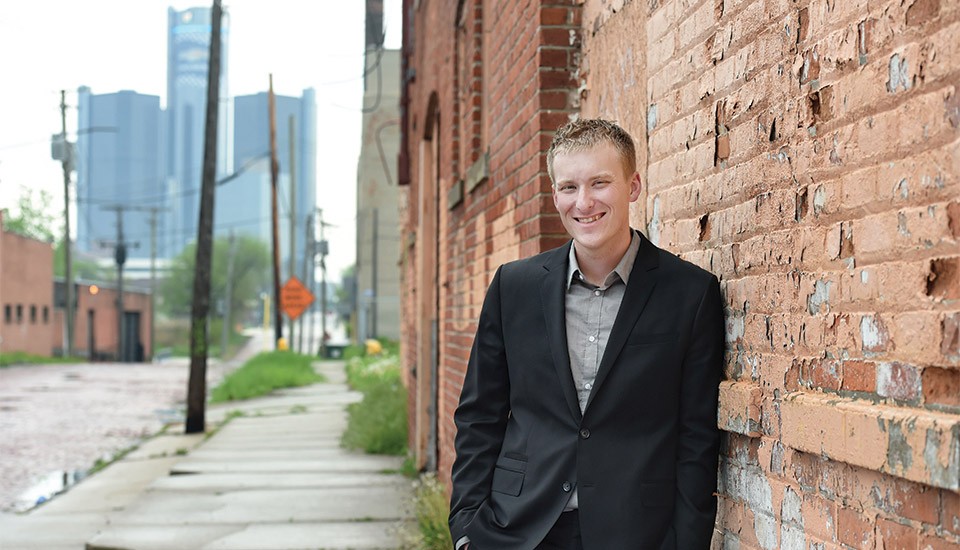
The March 23 Facebook post captured the moment for Nathan Bomey (BS06), a business reporter for USA TODAY.
“Going with the solid M&M lunch here at the New York Auto Show, because so far today I’ve tweeted, snapped, Facebooked, Periscoped, Instagrammed, written stories, taken photos and conducted interviews,” Bomey informed his friends and followers on the social media network. “And, well, now you support my M&M indulgence, don’t you?!”
Bomey’s candy-coated snapshot spotlights the new, 24/7, multitasking reality of journalism today for him and other reporters as they confront the intense pressure to reach their readers in the online world.
It’s a trend many veteran journalists lament. Yet Bomey, who graduated from Eastern Michigan University in 2006, echoes several other EMU alumni working in the field now—Justin Rogers, Kim Kozlowski and Katrease Stafford—in saying that journalism isn’t dead, it’s (most days) just excitingly different.
“You have to be all things to all people now,” Bomey says. “The tools through which you do good journalism have dramatically changed. It’s extremely engaging to be able to get instant feedback on your work through social media. Journalism is always alive today, the story is never static, and you do a better job because of it.”
Bomey’s had a front row seat on such change since enrolling at EMU in 2002 and working all four of his college years for The Eastern Echo, including a stint as a top editor. After graduating from Eastern in 2006, he enjoyed three-year runs at the Ann Arbor Business Review, AnnArbor.com (the online successor to The Ann Arbor News), and The Detroit Free Press before ending up at USA TODAY last spring.
He now works for the Money Section, where his beat includes autos, energy and breaking business news. This story caught Bomey while he was in Los Angeles promoting his new book, “Detroit Resurrected,” which chronicles the city’s bankruptcy and subsequent grand bargain bailout.
“When I was at The Echo, we had a website, Facebook was just starting and Twitter didn’t exist,” Bomey recalls. “The Web was not a priority. To go from that to an industry in which digital comes first is a significant change. It requires you to be extremely adaptable, willing to try new things and not be married to any old perception of what journalism should be.”
For Bomey, that means immediately communicating breaking news and analysis to his many followers on Twitter, along with coordinating with the USA TODAY social media team to ensure they’re on top of the story as well.
“Social media allows you to reach out and grab readers’ attention,” Bomey says. “Newspapers expected readers to come to them, and that routine has been shattered by the Internet. Now, you have to be imbedded in peoples’ digital lives with a personal brand that represents breaking news and good journalism.”
While Twitter represents an avenue for reporting news, it also serves as a way to interact, gather information, and develop sources, Bomey says, noting that even the high-speed newswires such as the Associated Press are now slower than social media.
The challenge, of course, is that the online world never sleeps. Journalists can constantly be updating stories; Bomey is now pushing aggressively into using Snapchat, an app described as “texting on steroids.” Bomey also uses a tool called Dataminr, which many news organizations employ to monitor topics trending on social media. The tool uses an algorithm that assesses who’s retweeting items, alerting reporters to surprise industry announcements or meaningful statements by key players.
Such a tool “helps and hurts,” Bomey says. “You don’t have to be on your Twitter feed all day, but you have to verify (the buzz). It’s really no different than getting a news tip on the phone in the old days. This is the philosophy that you have to have.”
For major news events such as the New York Auto Show this past March, Bomey focused on doing as much advance preparation as possible and then seamlessly switching among various platforms.
That meant gathering background material for a press conference and then live video streaming that event on a new app that Twitter developed called Periscope. Along with that came live tweets and posts on Snapchat and Instagram.
He also helped manage the USA TODAY Cars section Instagram account, along with other newspaper feeds.
“It’s tough to manage, no doubt about it,” Bomey says. “You ask yourself, ‘When does the day ever end?’ Social media never stops. That’s the challenge. You just have to be as vigilant as you can to set aside some time for yourself.”
Justin Rogers, (BS03), Detroit Lions beat reporter, MLive
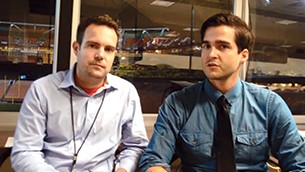
Like Bomey, Justin Rogers began his journalism career just as the Internet was taking off. Now, as one of two people covering the Detroit Lions for MLive, a statewide network of online operations based in cities including Ann Arbor, Saginaw and Grand Rapids, he’s fully immersed in the round-the-clock routine of feeding the insatiable information needs of NFL fans.
“I figured out one year that I basically wrote half a million words that were published,” Rogers says. “And that’s not counting the tweets. That’s so crazy to think. On top of that, we’re doing videos and podcasts.
“The grind can really wear on you. To be a sports journalist now, you have to have an elite level work ethic and love what you do. You’re not writing just a story anymore. You have to be part of the conversation in terms of social interaction, and have to have a diverse multimedia skill set.”
Rogers had anything but that when he graduated from Eastern in 2003 after majoring in English and minoring in philosophy. He had to work through college, so he had no time for the campus newspaper.
But Rogers, who had transferred to EMU after studying engineering at Kettering University, was determined to try journalism.
He networked and contacted a bevy of sports editors, only one of whom gave him a shot. Eric Braun, over at the then-fledgling digital operation of MLive, gave Rogers a job entering data.
Rogers did so well at that he was eventually running the digital sports operation and then became a sports writer when Booth Newspapers, a group of mid-sized papers in Michigan including The Ann Arbor News, merged with MLive.
When Booth’s longtime Lions beat writer Tom Kowalski suddenly passed away several years ago, Rogers took over the beat on an interim basis, moved back out of the role for six months and then was put back in after a staff shuffle. He now shares the beat with Kyle Meinke.
During the season, it’s beyond grueling, with 60- to 70-hour workweeks filled with press conferences, film review, constant social media updates and interaction with eager fans from around the country.
The 12- to 14-hour routine of game day begins 2-3 hours before kickoff with a clear bottom line: Produce quality content, and lots of it. Rogers provides a steady stream of material throughout the game, along with stories for the print edition.
Rogers and Meinke monitor TV and radio for pregame items that need sharing, produce updates after each quarter, and conduct a live game-day chat with fans on social media. Throughout the game they post on social media, interacting with their audience.
Any time a major injury occurs or a record is broken, it’s immediately reported. If Lions quarterback Matthew Stafford hits a milestone mark—boom!—they produce a story. No waiting for tomorrow’s paper.
Yet despite all this activity, the two still must churn out the staples of print sports coverage: A game story, a report card on facets of the game, analysis and relevant sidebars.
“Each game generates about 20 posts,” Rogers says. “It’s an amazing number to think about. But in the flow of a live event, it’s a lot easier. You definitely ride that adrenaline rush.”
Over the course of a year, the workload is astonishing. And when the games stop, the action doesn’t. This past spring meant covering the NFL draft, scouting combines and rookie minicamps.
And in the new, instant online world, Rogers serves as his own editor. Rarely is his copied checked before it’s published, and he writes his own headlines. He discusses the general direction of coverage with the MLive sports editor, but truly is his own boss.
“It’s one of the things I like—the trust,” Rogers says. “We produce a high level of content without micromanaging it.”
What can be lost amid all this online activity? Source development, Rogers says, calling it the most neglected part of his job.
“(The threshold) of what qualifies for being published online is so much lower than it used to be,” Rogers says, noting the proliferation of single-source stories. “But you can always update the story later when more information becomes available.”
The best part of the job? For Rogers, it’s educating the fans. He uses his math and science ability to help fans view the game from a more strategic, numerical and less emotional standpoint.
“I really take pride in being the logical middle man between the hyperbolic extremes of (angry) fans” and the team’s version of events, Rogers says. “I’ve spent a lot of time studying film, and this is the game about which the layman knows the least. If I can share what I learn with my audience, I can bring them along in the journey.”
Players and football staff notice Rogers’s expertise.
“I’ve gained a level of respect,” he says. “They don’t always agree with me, but they respect the effort and dedication I put in.”
Katrease Stafford (BA12), news reporter, The Detroit Free Press
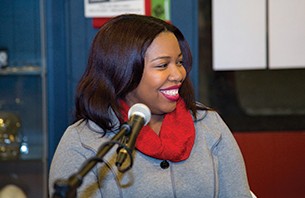
Stafford, a 2012 graduate of Eastern, is truly a product of the digital age. After working with the Eastern Echo, including a year as editor-in-chief, she got an internship with AnnArbor.com and soon became full-time there.
Within a year, she was hired at The Detroit Free Press, where she has often been tasked with getting older reporters up to speed on digital tools. “I actually had to learn print concepts at the Free Press,” she says, noting editors’ requests to turn in stories to length, such as 15 inches, to fit a newspaper hole. “It goes to show how these days younger journalists are trained differently.”
As a news reporter at the Free Press, Stafford’s job is to pounce on stories as quickly as possible. She closely monitors Twitter, both to check for developments and to get tips, many of them from regular citizens who simply follow news, know the city and often even go to crime sites.
Her beat is active and driven by tragedies, such as the recent Kalamazoo shootings by an Uber driver. Her editor called in the middle of the night and she was soon on the huge story – tweeting, doing videos of the scene and posting short voice clips.
Unlike some of her peers who work at smaller outfits, Stafford still has the cushioning element of editors in place at the Freep, which remains Michigan’s largest newspaper. “We have two sets of eyes before a story hits the Web,” Stafford says. “We haven’t felt the brunt (of the downsizing).”
Yet despite such oversight, Stafford revels in the creative freedom online journalists enjoy in controlling their content. “It’s pretty exciting,” she says. “You can create a package any way you want. That’s how the business is now, and it’s still evolving.”
Amid the technical aspects, Stafford strives to retain the human element in her reporting. One of her toughest stories at the Free Press, involving a mother who went missing with her two kids, recalled a lesson she had learned from EMU journalism professor Carol Schlagheck.
A missing person alert came from the Detroit Police, but the editors told Stafford to hold off; they often receive such alerts. A source called later with news that the mother had been found dead in a house.
Stafford arrived to find the family crying and grieving, yet it was her job to get details and reaction regarding the crime.
“It was a really tough story and a scary place to be,” Stafford recalls. “People were angry. But Carol always told us to never forget: The people you are interviewing are people. Be empathetic.
“Even just saying, ‘I’m sorry for your loss,’ even that little thing can mean the world. That lesson really stays with me.”
Kim Kozlowski (BS90), higher education reporter, The Detroit News
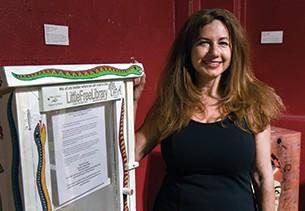
Kozlowski, a 1990 graduate of Eastern, is a veteran news reporter. Unlike Bomey, Stafford and Rogers, she worked years at traditional, single-deadline daily newspapers before having to master online skills on her beat, for which she covers all colleges—public, private and community—in Michigan.
“We have to always keep up on breaking news while juggling enterprise stories,” she says of working at the major metro paper. “Breaking news is a lot more important now. We now write stories the second we get them. We used to spend all day writing stories.”
Despite the complex topics she covers, Kozlowski promotes her stories via Twitter, Facebook and other platforms. From live events, such as meetings of the EMU Board of Regents, she will do live tweeting or even video, if visual elements such as a protest call for visual treatment.
“It’s a skill, and it’s certainly essential,” Kozlowski says of multimedia journalism. “It requires us to react more quickly. Sometimes it can be very exciting, and sometimes it can be stressful. But journalism is always fun, no matter what platform you are working on.”
After graduation, Kozlowski worked at the now-defunct Ypsilanti Press for three years, followed by stints at papers in upstate New York, and Grand Forks, N.D., as well as the Kansas City Star. She came to The Detroit News in 1999, and made the adjustment as the paper began to direct time and resources to its digital product.
Kozlowski applies a veteran reporter’s experience and sensitivity to her online efforts, mining information from social media and developing sources.
For instance, The Detroit News was the first to report about a Virginia Tech researcher, Marc Edwards, who led the way in investigating problems with Flint’s water supply. The tip came from a reader on Twitter, who asked why an out-of-town researcher and not someone local was looking at the problem.
Kozlowski notes that the skills imbedded in the new world of journalism can be beneficial away from the job, and not just to reporters. For instance, social media facilitated her own civic project—collaborating with others in establishing 150 Little Free Libraries around Detroit.
“It helped me reach people, and can be enormously helpful,” Kozlowski says. “And you can make noise about a lot of things, even if you are not media.”
Contact Darcy Gifford, dgiffor2@emich.edu , 734.487.5375

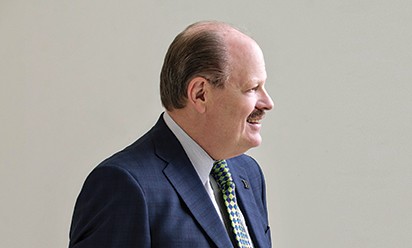 Charismatic leader takes over as EMU’s president
Charismatic leader takes over as EMU’s president
 Business mogul Aleksandra Efimova lives her college vision
Business mogul Aleksandra Efimova lives her college vision
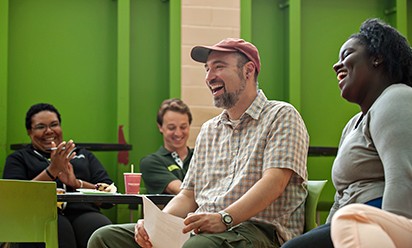 A Conversation with Ethan Lowenstein: Learning comes alive when students engage in place-based education.
A Conversation with Ethan Lowenstein: Learning comes alive when students engage in place-based education.